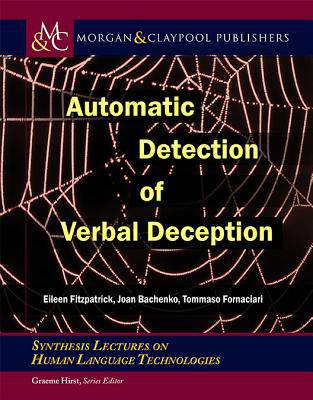
- Afhalen na 1 uur in een winkel met voorraad
- Gratis thuislevering in België vanaf € 30
- Ruim aanbod met 7 miljoen producten
- Afhalen na 1 uur in een winkel met voorraad
- Gratis thuislevering in België vanaf € 30
- Ruim aanbod met 7 miljoen producten
Zoeken
Omschrijving
The attempt to spot deception through its correlates in human behavior has a long history. Until recently, these efforts have concentrated on identifying individual "cues" that might occur with deception. However, with the advent of computational means to analyze language and other human behavior, we now have the ability to determine whether there are consistent clusters of differences in behavior that might be associated with a false statement as opposed to a true one. While its focus is on verbal behavior, this book describes a range of behaviors-physiological, gestural as well as verbal-that have been proposed as indicators of deception. An overview of the primary psychological and cognitive theories that have been offered as explanations of deceptive behaviors gives context for the description of specific behaviors. The book also addresses the differences between data collected in a laboratory and "real-world" data with respect to the emotional and cognitive state of the liar. It discusses sources of real-world data and problematic issues in its collection and identifies the primary areas in which applied studies based on real-world data are critical, including police, security, border crossing, customs, and asylum interviews; congressional hearings; financial reporting; legal depositions; human resource evaluation; predatory communications that include Internet scams, identity theft, and fraud; and false product reviews. Having established the background, this book concentrates on computational analyses of deceptive verbal behavior that have enabled the field of deception studies to move from individual cues to overall differences in behavior. The computational work is organized around the features used for classification from -gram through syntax to predicate-argument and rhetorical structure. The book concludes with a set of open questions that the computational work has generated.
Specificaties
Betrokkenen
- Auteur(s):
- Uitgeverij:
Inhoud
- Aantal bladzijden:
- 119
- Taal:
- Engels
- Reeks:
Eigenschappen
- Productcode (EAN):
- 9781627053372
- Verschijningsdatum:
- 1/09/2015
- Uitvoering:
- Paperback
- Formaat:
- Trade paperback (VS)
- Afmetingen:
- 190 mm x 235 mm
- Gewicht:
- 217 g

Alleen bij Standaard Boekhandel
+ 102 punten op je klantenkaart van Standaard Boekhandel
Beoordelingen
We publiceren alleen reviews die voldoen aan de voorwaarden voor reviews. Bekijk onze voorwaarden voor reviews.











